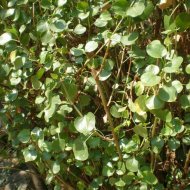Care of the shrub Rumex lunaria or Acetosa lunaria |
|
The genus Rumex, family Polygonaceae, includes some 120 species of perennial, biennial and annual plants with a cosmopolitan distribution. Some species are: Rumex lunaria, Rumex acetosa, Rumex maritimus, Rumex longifolius, Rumex obtusifolius, Rumex crispus. Scientific synonym: Acetosa lunaria. This species is native to the Canary Islands. They are evergreen shrubs branched from the base that reach 3 meters (9.84 feet) in height. The fleshy oval or cordate leaves are glossy dark green. They produce erect and dense green terminal inflorescences. They bloom in winter and spring. The showy and small reddish fruits are more decorative than the flowers. Acetosa lunaria is used on dry sunny slopes, to form informal hedges and screens, in shrubby groups, as isolated specimens, and in pots when young. It's ideal for Mediterranean coastal gardens. It's also used in folk medicine to treat insect and nettle stings, lung conditions, and hemorrhoids. Rumex lunaria can be grown in full sun and light shade exposures. Withstands light and occasional frosts. Acetosa lunaria grows in any well-drained soil whether sandy, stony, rocky or poor. Water moderately waiting for the substrate to dry. Rumex lunaria resists drought well when established. Fertilize with a little compost in autumn. Prune lightly in autumn to maintain a compact habit. Rumex lunaria is a plant resistant to the usual pests and diseases. Acetosa lunaria is propagated from seeds sown in autumn or spring and by cuttings. |
Images of the shrub Rumex lunaria or Acetosa lunaria |
Find plants
Rumex lunaria or Acetosa lunaria | Care and Growing
© 2025 FavThemes


